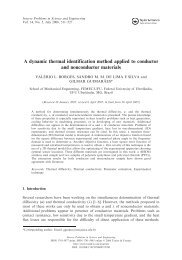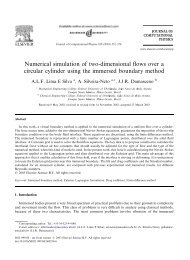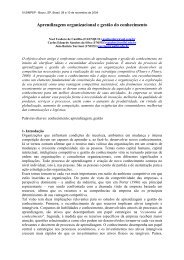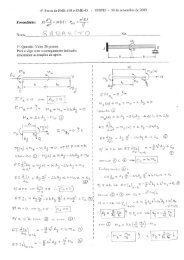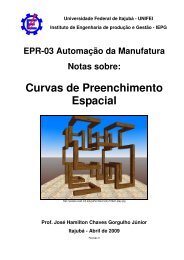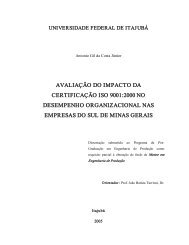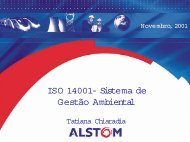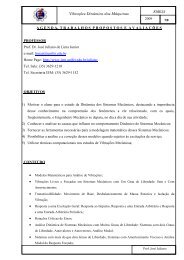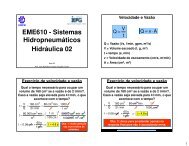Evaluation and analysis of criteria and sub-criteria of a ... - Emerald
Evaluation and analysis of criteria and sub-criteria of a ... - Emerald
Evaluation and analysis of criteria and sub-criteria of a ... - Emerald
You also want an ePaper? Increase the reach of your titles
YUMPU automatically turns print PDFs into web optimized ePapers that Google loves.
ECAM15,124<strong>sub</strong>-<strong>criteria</strong> <strong>of</strong> the model were measured in the analytical part <strong>of</strong> a questionnairesurvey. The <strong>criteria</strong> <strong>and</strong> <strong>sub</strong>-<strong>criteria</strong> were measured for both their importance <strong>and</strong>actual performance within the company <strong>of</strong> the respondent. Third, the data collectedwas prepared for further <strong>analysis</strong> through coding, missing data <strong>analysis</strong>, <strong>and</strong> dataexploration. Fourth, the questionnaire was evaluated as a measuring instrument interms <strong>of</strong> reliability <strong>and</strong> validity. Fifth, the <strong>criteria</strong> <strong>and</strong> <strong>sub</strong>-<strong>criteria</strong> were evaluatedthrough their importance measurement, via factor <strong>analysis</strong>, <strong>and</strong> through theireffectiveness measurement. Finally, weights <strong>of</strong> the model <strong>criteria</strong> were computed on anempirical basis using factor regression coefficients. The steps <strong>of</strong> evaluation arediscussed in the sections to follow.The proposed construction excellence modelThe construction excellence model under evaluation was developed <strong>and</strong> described inBassioni et al. (2004a, 2005) <strong>and</strong> is illustrated in Figure 2. The model is divided intoenabling <strong>and</strong> results <strong>criteria</strong>. The enabling <strong>criteria</strong> include: leadership; customers <strong>and</strong>stakeholder focus; strategic management; information <strong>and</strong> <strong>analysis</strong>; people,partnerships, suppliers, physical resources, intellectual capital, risk, work culture,<strong>and</strong> process management. The results <strong>criteria</strong> include: internal stakeholder; project,external stakeholder; <strong>and</strong> organisational business results. The logic <strong>of</strong> the model startswith leadership as the main driver for change <strong>and</strong> improvement in organisations.Leadership should guide the focus on customers, people <strong>and</strong> other relevantstakeholders, which in turn should guide the development <strong>of</strong> strategic plans. Thestrategic plans are further detailed into functional or programmatic business plans thatare translated into processes for implementation. Once implemented on projects <strong>and</strong>throughout the organisation, improved internal stakeholder results should start toappear (internal in terms <strong>of</strong> being under direct influence <strong>of</strong> management), such as that<strong>of</strong> employees, suppliers <strong>and</strong> other internal stakeholders. This will reflect on projectresults that would further affect customer <strong>and</strong> external stakeholder results not underthe direct management influence <strong>of</strong> the organisation. The outcome is business resultsbeing achieved on the organisational level. Work culture is seen to be driven byleadership, <strong>and</strong> affecting other enabling <strong>criteria</strong>, whereas information <strong>and</strong> <strong>analysis</strong> isalso driven by leadership <strong>and</strong> supports all other <strong>criteria</strong> throughout the model. Thebi-directional relationships between information <strong>and</strong> <strong>analysis</strong> <strong>and</strong> other <strong>criteria</strong>provide forward <strong>and</strong> backward loops <strong>of</strong> information among <strong>criteria</strong>.Measurement <strong>of</strong> model <strong>criteria</strong> <strong>and</strong> <strong>sub</strong>-<strong>criteria</strong>The measurement <strong>of</strong> the model’s <strong>criteria</strong> <strong>and</strong> <strong>sub</strong>-<strong>criteria</strong> was conducted through aquestionnaire survey. This section discusses the design <strong>of</strong> the questionnaire showinghow the <strong>criteria</strong> <strong>and</strong> <strong>sub</strong>-<strong>criteria</strong> were measured, <strong>and</strong> the sampling approach <strong>of</strong> thesurvey.Questionnaire designThe questionnaire is divided into three questions, as can be seen in the Appendix(Figure A1). The first question aims to identify the importance <strong>of</strong> each criterion inimproving organisational business performance results. It uses a five-point Likert scale



